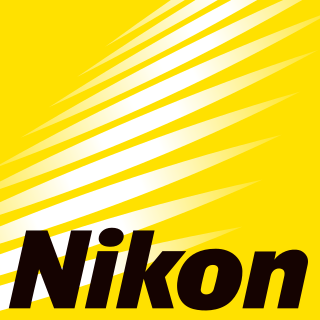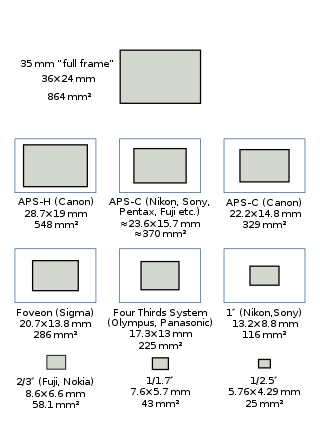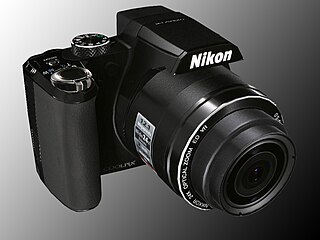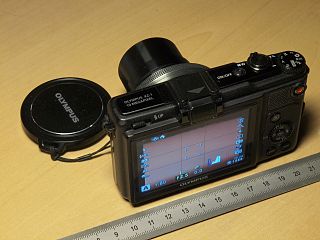
A digital camera is a camera that captures photographs in digital memory. Most cameras produced today are digital, largely replacing those that capture images on photographic film. Digital cameras are now widely incorporated into mobile devices like smartphones with the same or more capabilities and features of dedicated cameras. High-end, high-definition dedicated cameras are still commonly used by professionals and those who desire to take higher-quality photographs.

Nikon Corporation, also known just as Nikon, is a Japanese multinational corporation headquartered in Tokyo, Japan, specializing in optics and imaging products. The companies held by Nikon form the Nikon Group.
The Nikon Coolpix series are digital compact cameras in many variants produced by Nikon. It includes superzoom, bridge, travel-zoom, miniature compact and waterproof/rugged cameras.

The Nikon Coolpix 950 was a digital camera released by Nikon in early 1999. The 950 model superseded the Coolpix 900 in the Nikon Coolpix series. The Coolpix 950 was a durable camera with swivel lens, magnesium body, a maximum resolution of 1600×1200, 3× optical zoom and a minimum focusing distance of 2 cm. It was in turn superseded by the Coolpix 990.

A digital single-lens reflex camera is a digital camera that combines the optics and the mechanisms of a single-lens reflex camera with a digital imaging sensor.

Advanced Photo System type-C (APS-C) is an image sensor format approximately equivalent in size to the Advanced Photo System film negative in its C ("Classic") format, of 25.1×16.7 mm, an aspect ratio of 3:2 and Ø 31.15 mm field diameter. It is therefore also equivalent in size to the Super 35 motion picture film format, which has the dimensions of 24.89 mm × 18.66 mm and Ø 31.11 mm field diameter.

A full-frame DSLR is a digital single-lens reflex camera (DSLR) with a 35 mm image sensor format. Historically, 35 mm was one of the standard film formats, alongside larger ones, such as medium format and large format. The full-frame DSLR is in contrast to full-frame mirrorless interchangeable-lens cameras, and DSLR and mirrorless cameras with smaller sensors, much smaller than a full 35 mm frame. Many digital cameras, both compact and SLR models, use a smaller-than-35 mm frame as it is easier and cheaper to manufacture imaging sensors at a smaller size. Historically, the earliest digital SLR models, such as the Nikon NASA F4 or Kodak DCS 100, also used a smaller sensor.

Bridge cameras are cameras that fill the niche between relatively simple point-and-shoot cameras and interchangeable-lens cameras such as mirrorless cameras and single-lens reflex cameras (SLRs). They are often comparable in size and weight to the smallest digital SLRs (DSLR), but lack interchangeable lenses, and almost all digital bridge cameras lack an optical viewfinder system. The phrase "bridge camera" has been in use at least since the 1980s, and continues to be used with digital cameras. The term was originally used to refer to film cameras which "bridged the gap" between point-and-shoot cameras and SLRs.

The Pentax K10D and similar Samsung GX-10 are 10.2-megapixel digital single-lens reflex cameras launched in late 2006. They were developed in a collaboration between Pentax of Japan and Samsung of South Korea.

A swivel lens is a lens that freely rotates while attached to a camera body. They are used on some compact digital and video cameras (camcorders). These lenses make it easy for a photographer to aim a camera without moving around too much. Swivel lenses come in different sizes and shapes. A swivel lens is also known as a swiveling lens, swivelling lens, and rotating lens.

The Coolpix P80 is a point-and-shoot digital camera produced by Nikon that was introduced in April 2008.

The Nikon Coolpix P90 was launched by Nikon on 3 February 2009 as an improved version of the Nikon Coolpix P80. It is a 12-megapixel CCD digital camera with a fixed 24× zoom lens giving more than twelve times image magnification fully extended.

A mirrorless camera is a photo camera featuring a single, removable lens and a digital display. The camera does not have a reflex mirror or optical viewfinder like a digital single-lens reflex (DSLR) camera, but may have an electronic viewfinder. Many mirrorless cameras retain a mechanical shutter. Like a DSLR, a mirrorless camera accepts any of a series of interchangeable lenses compatible with its lens mount.

The Olympus XZ-1 is a high-end 10.0 megapixel compact digital camera announced and released in January 2011. Its key features are a fast f/1.8-2.5 i.Zuiko Digital lens, a built in imager shift image stabilizer and Olympus' 6 Art Filters that are also present in the E-PEN series.

The Nikon Coolpix A is digital large-sensor compact camera announced by Nikon on March 5, 2013. It is Nikon's first consumer-oriented camera with a DX (APS-C) sensor, announced on March 5, 2013. It is the company's flagship Coolpix camera, but has Program/Shutter priority/Aperture priority/Manual (PSAM) modes and menu system which is much more similar to a DSLR than its Coolpix predecessors.

The Samsung NX mini is a digital rangefinder-style interchangeable lens mirrorless camera announced by Samsung on March 19, 2014.

The Nikon D5600 is a 24.2 megapixel upper-entry level, APS-C sensor DSLR announced by Nikon on November 10, 2016, as the successor of the D5500. The camera has an F-mount.















